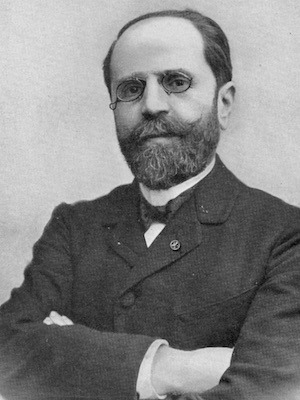Edgard Hirtz
Biography
- Born 30 May 1849 Winzenheim, Germany
- 1887 – Physician at the Hopitaux de Paris
- 1910 – Head of Necker Hospital, Paris
- 1910 – Officier de la Légion d’honneur
- Died 24 December 1916
Medical Eponyms
Hirtz Sign (1911)
Chronic pericardial effusion: the improvement in the symptomatic shortness of breath when the patient assumes the ‘knee-chest position’ [genu-pectorale]
Hirtz described the genu-pectorale position as a sign of pericarditis in a patient with acute generalized articular rheumatism and dyspnoea. He acknowledged that Zehetmayer (1845) and Merklen (1892) each reported cases of large pericardial effusions relieved with positional changes.
…[the patient] was obliged to sit up, leaning forward for a few minutes at a time, but even this position did not give him the desired relief. The patient was relieved of his dyspnea only when he assumed the knee-chest position, which he instinctively took himself. It is this singular position which attracted my attention when I first saw the patient. He was upon his knees on the bed, his body bent forward, and supported by his elbows. The first sight of this individual in a condition of intense anxiety, cyanosis, and very short of breath, bent forward in the knee-chest position made me think of the possibility of pericarditis with marked effusion, even without proceeding with the examination. I believe, in fact, that the knee-chest position necessitated by an intense dyspnea is characteristic sign of pericarditis with large effusions. While this sign is rare, it seems to have a definite value; for in my experience it always indicates the presence of a large pericardial effusion
Hirtz 1911; 14
Further commentary on the Hirtz publication from Babonneix in the Gazette des Hôpitaux civils et militaires
La position genu-pectorale. Signe pathognomonique des péricardites à gros épanchement. Il s’agit d’un sujet en état de dyspnée considérable, que seule soulageait la position genu-pectorale qu’il prenait instinctivement de lui-même. Le diagnostic porté dans ce cas fut celui de péricardite à gros épanchement: la ponction permit, en effet, de retirer du péricarde 480cc de liquide citrin séro-fibrineux. Pour M. le docteur Hirtz, cette position genu-pectorale nécessitée par une dyspnée intense est un signe pathognomonique des péricardites à gros épanchement. Un tel symptôme a d’ailleurs été déjà signalé en 1845 par Zehetmayer à Vienne, par Merklen, en 1892, dans la. Semaine médicale, et par M. Hirtz, lui-même, en 1898, à l’hôpital Laënnec.
Babonneix 1911
The knee-chest position. Pathognomonic sign of pericarditis with large effusion. This is a subject in considerable dyspnea, which only relieved the genu-pectoral position which he instinctively assumed of himself. The diagnosis carried in this case was that of pericarditis with large effusion: the puncture made it possible, in fact, to remove 480cc of sero-fibrinous citrin liquid from the pericardium. For Dr. Hirtz, this genu-pectoral position necessitated by intense dyspnea is a pathognomonic sign of pericarditis with large effusion. Such a symptom was already reported in 1845 by Zehetmayer in Vienna, by Merklen, in 1892, in the Medical week, and by Mr. Hirtz, himself, in 1898, at Laënnec Hospital.
Babonneix 1911
and an editorial in the Buffalo Medical Journal
M. Edgar Hertz, of the Necker Hospital, Paris, (La Tribune Médicale, May, 1911), cites four cases of pericarditis with marked effusion in which relief of the dyspnea was secured by the knee chest posture, by the spontaneous endeavors of the patient himself to find a comfortable position. He knows of no other condition in which the patient assumes this posture of his own accord. The action seems to be purely mechanic and not due to the exact pathologic lesion as the sign has been noted in rheumatic, tuberculous, post-scarlatinal and nephritic pericardial effusion. We would add the caution that this sign is merely suggestive; also that when the knee chest posture is not spontaneously assumed by the patient it might be well to place him in it, if necessary with a pillow T or strap support, both for diagnostic and therapeutic purposes.
Buffalo Medical Journal. 1912
Controversies
Major Publications
- Hirtz E. La position genu-pectorale, signe pathognomonique des pericardites a gros epanchement. La Tribune médicale. 1911; 14: 1
- Hirtz E. Titres et travaux scientifiques. 1911
References
- Babonneix L. La position genu-pectorale: signe pathognomique des péricardites à gros épanchement. Gazette des Hôpitaux civils et militaires 1911; 84: 941.
- Marc Frenkel. La position génu-pectorale, signe pathognomonique de la forme dyspnéique des péricardites à gros épanchement. Thèse de Paris, 1911
- Editorial. Knee Chest Position as a Sign of Pericarditis. Buffalo Medical Journal. 1912; 67: 49
- Obituary. Dr. Edgard Hirtz. Br Med J 1917; 1: 247
- Edgard Hirtz. La Presse médicale 1917; 2: 13-14
- Collection of portraits: Dr Hirtz: CIPH0221
- Edgard Hirtz (1849-1916). data BNF
- Hirtz, Edgard. BIU Health – Medicine
- Ye F et al. Physical Signs of Inspection and Medical Eponyms in Pericarditis Part III: 1900 to 1964. Erclyes Med J 2019; 41(3): 348-54

eponym
the person behind the name

